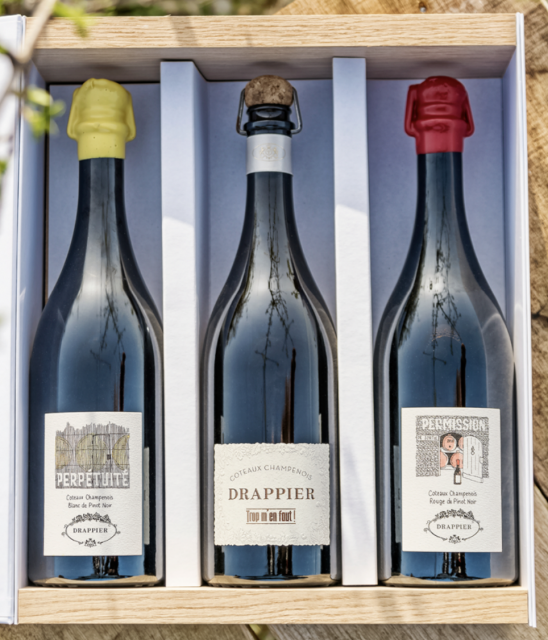This website uses cookies so that we can provide you with the best user experience possible. Cookie information is stored in your browser and performs functions such as recognising you when you return to our website and helping our team to understand which sections of the website you find most interesting and useful.
Champagne Drappier launches still wines, including organic Pinot Gris
Champagne Drappier has launched a set of three still wines, including a red and white from Pinot Noir, along with an organic white from Pinot Gris – a grape best known by its Italian name, Pinot Grigio.

Although extremely rarely seen in Champagne, which is a region dominated by three grapes – Pinot Noir, Meunier and Chardonnay – there are in fact seven varieties that can be used in the making of this famous fizz.
The additional four are all white grapes, called Arbanne, Petit Meslier, Pinot Blanc and Pinot Gris – known locally as Fromonteau – and Drappier is one of the very few producers in Champagne to have plantings of all seven varieties.
The most recent to be planted at Drappier’s estate in the southerly part of Champagne, around the village of Urville in the Aube, is Fromonteau, which was put in the ground in 2012, and destined for using in Champagne, with, as first reported by db, an idea to use the grape in a very sweet style of fizz, similarly to what was produced historically by the region.
However, it was revealed to db earlier today that Drappier has used Fromonteau from the 2017 and 2018 harvests in Champagne to produce a barrel-fermented still white wine, and the wine is certified organic.
Drappier has also made a still red Pinot Noir from 2018, while it is bottling a still ‘blanc de noirs’ using the same grape from the 2020 harvest.
All the wines come under the classification for still wines made in Champagne using the region’s permitted varieties, which is ‘Coteaux Champenois’.
The triumvirate of wines have been named Trop M’En Faut!, Permission, and Perpétuité, and will be distributed by Berkmann Wine Cellars in the UK.
News of these still wines from Drappier follows a release of Coteaux Champenois from Champagne Louis Roederer, which was announced by db in Februrary this year, when the house unveiled a pair of single vineyard wines, one from Chardonnay, and the other using Pinot Noir.
While Pinot Gris is a native French grape, it is best known by its Italian name, Pinot Grigio, as this country has more plantings of the variety than another other nation in the world, specifically in the north east area of Italy, close to Venice.
Back in Champagne, head of Drappier, Michel Drappier, said the release of his wines to the market was simply continuing a tradition of still wine production at the estate for local consumption, while harking back to the history of Champagne, which of course started life as an area for producing still wines.
He explained that since 1808, when the Drappier vineyards were first planted, the family had been producing red and white still wine, and that his grandfather, Georges, was locally renowned for producing excellent still wine from a ‘southern’ cru, where, it’s recalled that “the ripened grapes were superior to those in other villages”.
According to Drappier, the family has always made what was then called ‘Urville Rouge’ and ‘Vin Nature de la Champagne’, and, when the AOC was declared in 1974, the wine became known as ‘Coteaux Champenois’.
And, looking ahead, Michel predicted a Burgundy-like still wine future for Champagne due to climate change.
“As the climate warms, the quality of Champagne’s still wines will evolve. With our limestone soil and the right weather, we’ll be close to the Burgundy of thirty years ago. Our red and white wines will doubtless be excellent,” he said.
However, at present, he said that still wines – representing just 0.7% of the region’s production – represented a “drop in the ocean of Champagne”.

